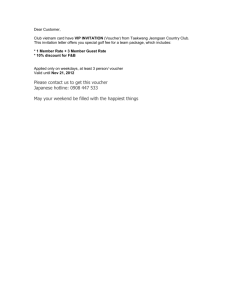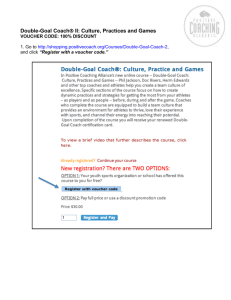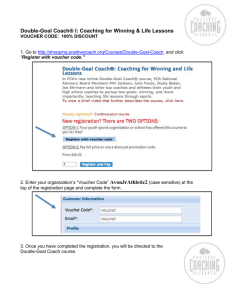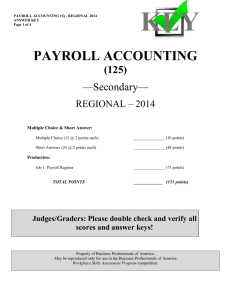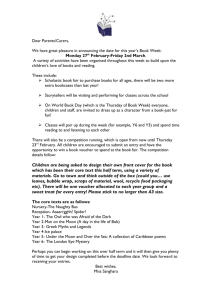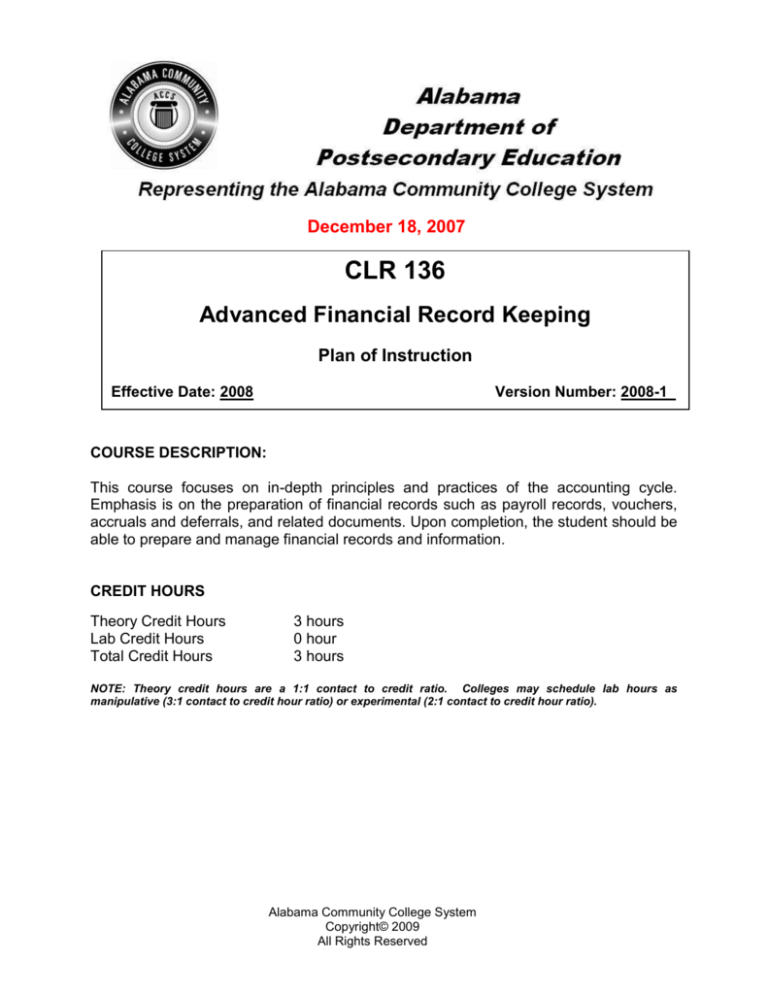
December 18, 2007
CLR 136
Advanced Financial Record Keeping
Plan of Instruction
Effective Date: 2008
Version Number: 2008-1
COURSE DESCRIPTION:
This course focuses on in-depth principles and practices of the accounting cycle.
Emphasis is on the preparation of financial records such as payroll records, vouchers,
accruals and deferrals, and related documents. Upon completion, the student should be
able to prepare and manage financial records and information.
CREDIT HOURS
Theory Credit Hours
Lab Credit Hours
Total Credit Hours
3 hours
0 hour
3 hours
NOTE: Theory credit hours are a 1:1 contact to credit ratio. Colleges may schedule lab hours as
manipulative (3:1 contact to credit hour ratio) or experimental (2:1 contact to credit hour ratio).
Alabama Community College System
Copyright© 2009
All Rights Reserved
Advanced Financial Record Keeping
CLR 136
PREREQUISITE COURSES
As determined by college.
CO-REQUISITE COURSES
As determined by college.
INSTRUCTIONAL NOTE:
This course is designed to provide students with more in-depth knowledge of
accounting. The focus will be accounting for cash, payroll accounting, the voucher
system, and special journals.
PROFESSIONAL COMPETENCIES
Explain the procedures followed in accounting for cash.
Prepare payroll records and record journal entries related to payroll.
Use the voucher system.
Describe and explain the purposes of, and identify transactions recorded in
special journals.
INSTRUCTIONAL GOALS
Cognitive – Comprehend principles and concepts related to advanced financial
record keeping.
Psychomotor – Apply principles and concepts of advanced financial record
keeping.
Affective – Value the importance of adhering to policy and procedures related to
advanced financial record keeping.
STUDENT OBJECTIVES
Condition Statement: Unless otherwise indicated, evaluation of student’s attainment
of objectives is based on knowledge gained from this course. Specifications may be in
the form of, but not limited to, cognitive skills diagnostic instruments, manufacturer’s
specifications, technical orders, regulations, national and state codes, certification
agencies, locally developed lab/clinical assignments, or any combination of
specifications.
ACCS Copyright© 2009
All Rights Reserved
2
Advanced Financial Record Keeping
CLR 136
STUDENT LEARNING OUTCOMES
MODULE A – ACCOUNTING FOR CASH
MODULE DESCRIPTION – The purpose of this module is to teach the students to explain
the procedures followed in accounting for cash. Topic include Checking accounts,
reconciliation journal entries, petty cash fund, change fund, and a cash short and over
account.
PROFESSIONAL COMPETENCIES
A1.0
Explain the procedures
followed in accounting for
cash.
PERFORMANCE OBJECTIVES
A1.1
Prepare a bank reconciliation and
related journal entries accurately.
LEARNING OBJECTIVES
KSA
2
KSA
A1.1.1 Describe how to open and use a checking account.
A1.1.2 Prepare a bank reconciliation and related journal entries.
A1.1.3 Explain the use of a petty cash fund.
A1.1.4 Explain the use of a change fund.
A1.1.5 Explain the use of a cash short and over account
MODULE A OUTLINE:
Checking account
Manage a checking account
o Parts of a check
o Steps in preparing a check
Deposit slips
Signature card
Endorsements
Bank reconciliation and related journal entries
Deposits in transit and related errors
Outstanding checks and related errors
Additional reconciling items
Journal entries
Petty cash fund
Petty cash fund establishment
Payments from a petty cash fund
Petty cash payments record
Petty cash fund replenishment
Change fund
Cash short and over account
2
2
2
2
2
ACCS Copyright© 2009
All Rights Reserved
3
Advanced Financial Record Keeping
CLR 136
MODULE B – PAYROLL RECORDS
MODULE DESCRIPTION – The purpose of this module is to teach the students to
prepare payroll records and record journal entries related to payroll. Topics include
payroll registers, employee’s earnings record, and employee earnings and deductions.
PROFESSIONAL COMPETENCIES
PERFORMANCE OBJECTIVES
KSA
B1.0 Prepare payroll records and
B1.1 Accurately prepare payroll records
2
record journal entries related to
and record journal entries
payroll.
according to specifications.
LEARNING OBJECTIVES
KSA
B1.1.1 Explain how to define and prepare a payroll register.
B1.1.2 Explain how to define and prepare an employee’s earnings record.
B1.1.3 Explain how to calculate employee earnings and deductions.
B1.1.4 Describe and calculate employer payroll taxes
B1.1.5 Describe employer reporting and payment responsibilities.
B1.1.6 Describe and account for workers’ compensation insurance.
MODULE B OUTLINE:
Payroll Register
Definition of payroll register
Steps in completing a payroll register
Employee’s Earnings Record
Definition of employee’s earnings record
Steps in completing an employee’s earnings record
Employee Earnings and Deductions
Salaries and Wages
Gross Pay
Deductions
o Income tax
o FICA tax
o Voluntary deductions
Net Pay
2
2
2
2
2
2
ACCS Copyright© 2009
All Rights Reserved
4
Advanced Financial Record Keeping
CLR 136
MODULE C – VOUCHER SYSTEM
MODULE DESCRIPTION – The purpose of this module is to teach the students to use the
voucher system. Topics include voucher system preparation, completion, and schedule of
vouchers payable.
PROFESSIONAL COMPETENCIES
PERFORMANCE OBJECTIVES
KSA
C1.0 Use the voucher system.
C1.1 Accurately prepare a voucher,
2
complete a voucher register, and
prepare a schedule of accounts
payable according to
specifications.
LEARNING OBJECTIVES
C1.1.1 Describe how a voucher system is used to control expenditures.
C1.1.2 Explain how to prepare a voucher.
C1.1.3. Describe and explain the use of a voucher register.
C1.1.4 Describe and explain the payment process using a voucher system.
C1.1.5 Describe and explain the use of a check register.
C1.1.6 Explain how to prepare a schedule of vouchers payable.
MODULE C OUTLINE:
Definition and preparation of a voucher
Steps in completing a voucher register
Definition and preparation of a schedule of vouchers payable
KSA
2
2
2
2
2
2
MODULE D – SPECIAL JOURNALS
MODULE DESCRIPTION – The purpose of this module is to teach the students to
describe and explain the purposes ob and identify transactions recorded in special
journals. Topics include combination journals, sales journals, purchases journal, cash
payments, and cash receipts.
PROFESSIONAL COMPETENCIES
PERFORMANCE OBJECTIVES
KSA
D1.0 Describe and explain the
D1.1 This competency is measured
2
purposes of, and identify
cognitively.
transactions recorded in
special journals.
LEARNING OBJECTIVES
KSA
D1.1.1 Describe and explain the use of the combination journal.
D1.1.2 Describe and explain the use of the sales journal and accounts receivable
2
2
ACCS Copyright© 2009
All Rights Reserved
5
Advanced Financial Record Keeping
CLR 136
ledger.
D1.1.3.Describe and explain the use of the purchases journal and the accounts
payable ledger.
D1.1.4 Describe and explain the use of the cash payments journal.
D1.1.5 Describe and explain the use of the cash receipts journal.
D1.1.6 Explain how to prepare a schedule of accounts receivable.
D1.1.7 Explain how to prepare a schedule of accounts payable.
MODULE D OUTLINE:
Combination journal
Sales journal
Purchases journal
Cash payments journal
Cash receipts journal
2
2
2
2
LEARNING OUTCOMES TABLE OF SPECIFICATIONS
The table below identifies the percentage of learning objectives for each module.
Instructors should develop sufficient numbers of test items at the appropriate
level of evaluation.
Limited
Knowledge and
Proficiency
1
Module A
Module B
Module C
Module D
ACCS Copyright© 2009
All Rights Reserved
Moderate
Knowledge
and
Proficiency
2
100%
100%
100%
100%
Advanced
Knowledge
and
Proficiency
3
Superior
Knowledge
and
Proficiency
4
6
Advanced Financial Record Keeping
Indicator
1
2
3
4
CLR 136
Learner’s Knowledge, Skills and Abilities
Key Terms
Description
Identifies basic facts and terms about the subject or
competency.
Limited
Knowledge Performs simple tasks associated with the
and
competency. Needs to be told or shown how to do
Proficiency
most tasks.
Requires close supervision.
Identifies relationship of basic facts and states
general principles and can determine step-by-step
Moderate
procedures for doing the competency.
Knowledge
and
Performs most parts of the competency. Needs help
Proficiency
only on hardest parts.
Requires limited supervision.
Analyzes facts and principles and draws conclusions
about the subject to include why and when the
Advanced
competency must be done and why each step is
Knowledge
needed. Can predict outcomes.
and
Performs all parts of the competency. Needs only a
Proficiency
spot check of completed work.
Requires little or no direct supervision.
Can evaluate conditions and make appropriate
Superior
decisions as related to resolving problems.
Knowledge
Performs competency quickly and accurately with no
and
direct supervision and is able to instruct and
Proficiency
supervise others.
ACCS Copyright© 2009
All Rights Reserved
7

